For a long time the AirPods Pros have operated in a very specific classification for me. They aren’t as well tuned as the best IEMs, nor do they have any of the “good” codecs that nerds love, but if you have an iPhone and want something that “just works” then they are the one you get. They are a perfectly acceptable tool, and I was more or less satisfied to replace lost buds and broken cases Ship of Theseus style but was in no rush to replace them. Then I made the mistake of turning on the last Apple event, saw they had added a heart rate monitor and cursed out loud. Apple had gotten my ass.
Matters of the heart
Last year I had a heart scare that lasted for several months. My heart was skipping beats occasionally, so my primary care physician recommended that I go to a cardiologist. This is something that happens more and more as you approach middle age, and the constant worry took a lot out of me. In my panic I did the thing many people do: seeing if spending money on gear could solve an existential problem.
When you begin to become aware of your own mortality, you will often end up at Apple. The actually good heart rate monitors are chest straps, but the wrist based ones do a decent enough job for exercise and occasionally flagging potential problems. Overwhelmingly the agreed-upon form factor is a smartwatch, but I am not a watch person no matter how many times I have tried because I fidget a bit too much and I don’t need another screen. They still make monitors shaped like fitbits that lack a display, but they’re ugly as sin or require a subscription. Smart Rings are promising, but none of them are particularly compelling aside from the Oura Ring, which requires a subscription, and it’s simply below my dignity to pay a subscription to a ring. I would love a good heart rate monitor that just looks like a plain metal band and is neither a narc nor draining my wallet monthly, but that product does not exist.
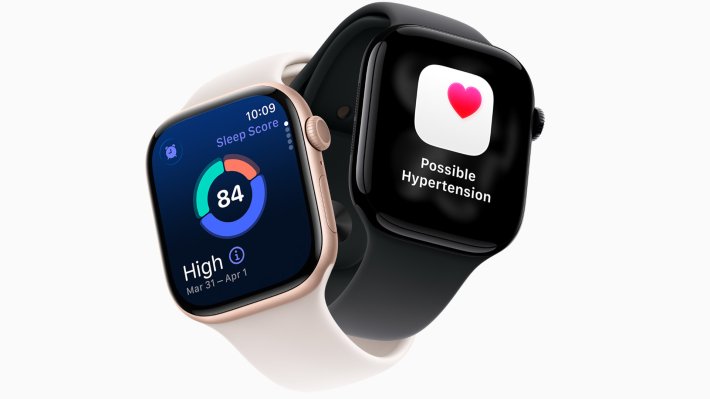
This is why Apple wins almost all the time by default. The entire wearables market is a mess, but the Apple Watch is simple, works with an ecosystem many people already have, and is a no brainer to give to an ailing or elderly relative. Health has become the primary reason many people buy Apple Watches, because unlike a lot of the technology currently propping up the unstable tech bubble, “I would like to know if I’m dying” is an easily parsable pitch to most people.
I went back and forth about buying an Apple Watch for a few months until, after half a dozen doctor’s visits, tons of stress, and a holter monitor, my doctor said “yeah no you’re fine, just keep an eye on it.” So I backbenched it until Apple announced that the AirPods Pro 3 would have heart rate monitors, thus providing an elegant solution to something I had been wracking my brain trying to solve. It would not replace going to the doctor, but it’s a clear upgrade that would require me to change absolutely no behavior since I live in New York and have at least one AirPod in whenever I go outside. In a bit of serendipity, the announcement coincided with me getting a refund from Midea for the recalled air conditioner I had initially reported on, which added up to basically the exact amount of money I needed to buy the AirPods.
An improved fit
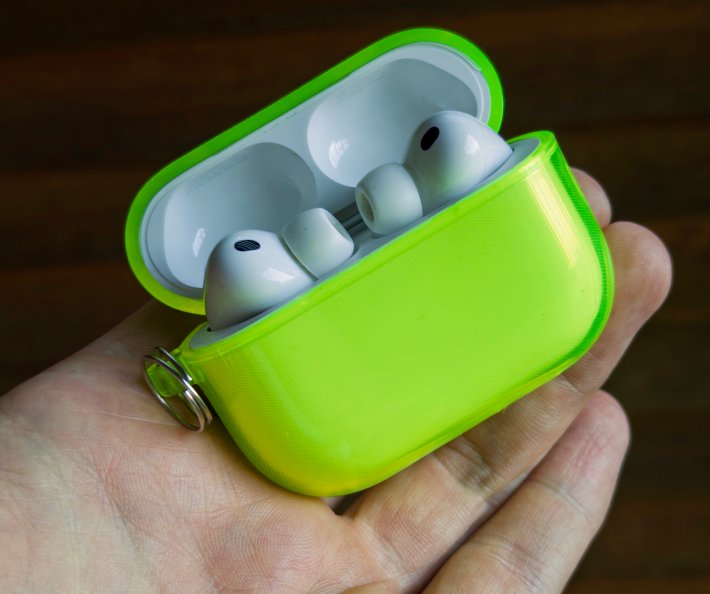
If the sole improvements in the AirPods Pro 3s had been a heart rate monitor and an extended battery, that probably would have been enough for me to shell out my cash, but there were thankfully other perks to make it a no brainer. One of the failings of the previous AirPod Pro models was the tips and the fit. AirPod Pro tips will eventually just get kind of shitty and rip, so there’s an entire aftermarket ecosystem of alternatives made by the same people who produce IEM tips. The aftermarket tip alternatives range from silicone to foam, although it’s difficult to tell long term if they will actually do a better job at tuning the headphone outside of improving the durability. Apple this time opted for a hybrid of the two, which bypasses the flaw of foam (it gets nasty) while leaning in on its strengths (a fit that really just gets in there.) Only time and abuse will tell if this was a wise decision.
Aside from improved waterproofing, one other big physical change is that the AirPods Pro 3 are just shaped differently, more like an ear canal. As a result, the buds get really in there and do a fairly good job at maintaining their grip. It is intimate and a tiny bit bizarre. My old AirPods Pro 2 did not fall out of my ears as frequently as I’ve seen other people complain about, but it happened enough to be a jump scare if I was anywhere near an open street grate. The AirPods Pro 3 feel much more secure, which I assume is necessary for the heart rate sensors to function. This also has the added improvement of having a better seal on the headphones, which in turn assists with noise cancellation.
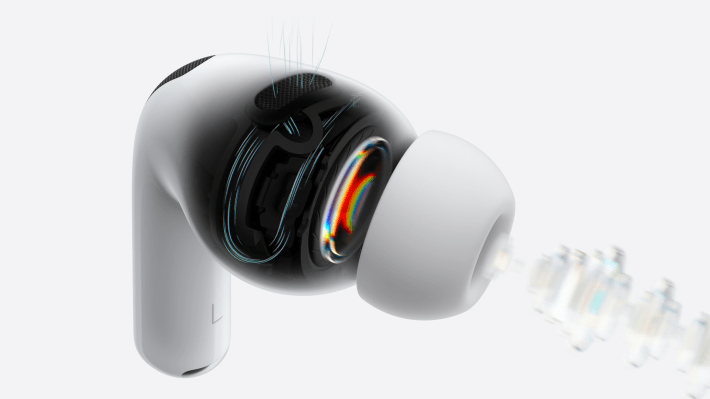
Though Apple boasted in their presentation that their noise cancellation had been radically improved, I was not prepared for how good it had gotten in practice until I tried them on. Part of it may just be that “new earbud” sensation when you turn on a fresh piece of hardware, but when I picked them up from an Apple Store in a very weird New York mall I was floored by how much of the world got entirely shut off. They did such a good job at locking me into my space that I missed two different buses home and had to get a car.
Everything is better except the sound
The AirPods Pro 3 sounds markedly different this time around, and this is the part where I have seen the most visceral reactions online. AirPods have always been tuned in a way that’s crowd pleasing but inoffensive – not fully neutral, but something you could give to basically everybody. There are two very notable differences in tuning from the AirPods Pro 2 to 3. First is the bass, which is noticeably more substantial now but may be a bit too much for some people. The second and more egregious is the treble, which is sharper and a bit more pronounced. They took a sound signature that was already slightly “V-shaped” and made the V deeper.
I tend to like a “bright” pair of headphones, and there are parts of how these headphones sound that I like a lot (the midrange and the sound stage in particular are great). But the line between clear and fatiguing is razor thin. It has been fascinating to see the reactions. Linus from Linus Tech tips got more pissed off than I have ever seen him get about a product (and had measurements by headphone expert DMS to back him up). Another YouTuber I like, Super* Review, roasted Linus a little for that, although claims he has his own quibbles. The Headphone Show was more measured than Linus’ original reaction but echoed many of his concerns. Uniformly, people who care about headphones seem a bit concerned, and their concern is justified – the changes Apple made are showy, bound to alienate people and not great if the goal of buying AirPods is simply “listening to music.”
"The AirPods Pro 3 goes for a more V-shaped sound signature, prioritizing a plump bass response and sparkly treble,” Griffin Silver aka “listener” from Headphones.com told me via DM. “While many consumers may ultimately find this more exciting sound to be an improvement, it's a bit of a shame that the more reserved, natural sound of the AirPods Pro 2 is being replaced by a sound profile that just seems overall a bit less safe"
This also points to a larger problem with Apple products, and that’s one of hubris. Apple spends an obscene amount of time and money to create products that they believe will satisfy the greatest number of consumers. They have mountains of research to back up their claims. You are not supposed to EQ the AirPods Pro 3, you are supposed to enjoy them. And to some degree they are correct; the headphones are a marvel in how they correct for the ear canal of the listener. But making a fairly noticeable change to how the successor to your flagship audio product sounds without giving people accustomed to it the ability to EQ it close to its predecessor is going to ruffle some feathers. They went from an inoffensive headphone tuning to something fairly divisive and a little tacky.
How Apple is approaching the sound signature of the AirPods Pro 3 is similar to how they have tuned their cameras: impressive to normal people but a little garish to anybody who is even semi-professional. There is no real way to actually EQ these headphones. Nobody would be as mad if they had thrown a Parametric EQ in a submenu for the people who are freaks and called it a day, or even thrown in an EQ profile that shifts it closer to the AirPods Pro 2. EQing is a feature that even the cheapest good wireless earbuds all have. If Sony ever pulled this shit with their headphones they’d be tarred and feathered for it, but Apple knows best.
Seamless heart rate monitoring
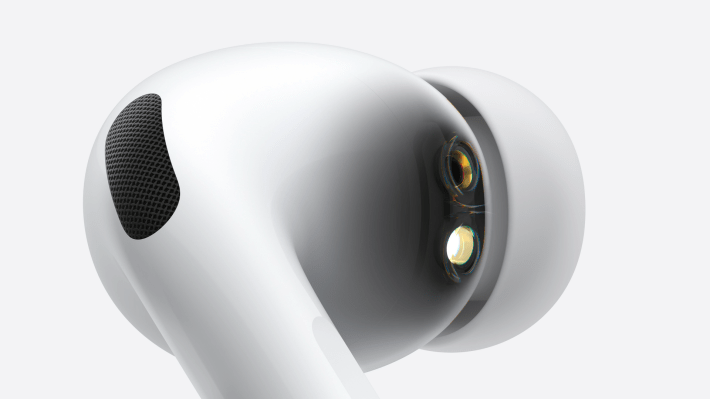
The entire reason for me getting this thing was to monitor my heart rate, and on that front the AirPods Pro 3 are fantastic given the form factor. If you are in the Apple ecosystem they just kind of integrate seamlessly, and work fairly well by all accounts. DC Rainmaker is one of the better reviewers out there for wearables and was blown away by how it performed, while noting some variability. Fit seems to make a huge difference on the performance of the hear trate tracker, and making sure the AirPods are positioned in the correct way with sufficient depth is key. I’ve read a lot of people online who have sized down their tips to get a snug fit.
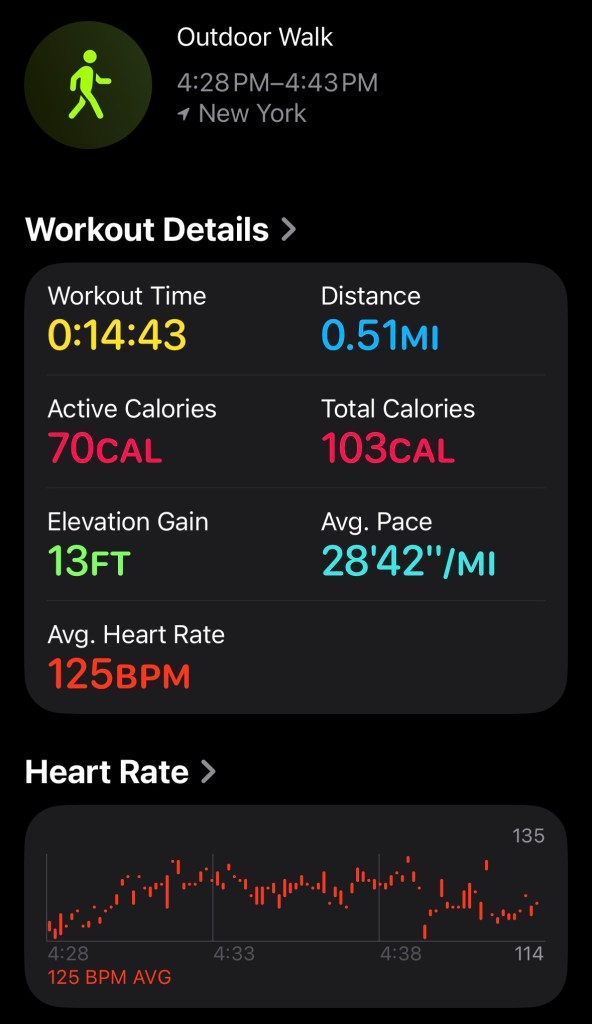
I could not rigorously test the heart rate monitor while lifting weights and cycling because my right foot shattered into several pieces and currently has metal pins protruding from it, but I am able to log my short walks using the iWalkFree, a task that is far more strenuous than it appears. The AirPods Pro 3 will periodically update your heart rate during the day or continuously when you use the Fitness app, so I have been using the app to log my walks. Third party support for the heart rate monitoring feature feels patchy currently, which makes sense given that the ecosystem was built with the Apple Watch in mind. You should not treat the AirPods Pro 3 as a medical device when it comes to heart health, but I am supremely impressed that Apple found a way to add beat tracking to active workouts in a product I already live with every day without changing much of the form factor.
(Beta) Translation
Apple has been fairly quiet about Apple Intelligence, perhaps because they spent a ton of time positioning it as the next big thing and so far everyone hates it because it sucks. One very noticeable exception during the last presentation was the Live Translation feature that’s now in opt-in beta for AirPods Pro 3, and AirPods Pro 2 and AirPods 4.
The idea of having a universal translator that’s just inside your ears has been a tech dream for decades, that’s just the Babel Fish from The Hitchhiker's Guide To The Galaxy. As far as AI products go, it’s a legible and practical idea that you could explain to an elderly parent in a half a sentence as opposed to “what if I asked my glasses how to make a sauce and they couldn’t.” Our stance on the topic of AI is clear, but it is worth testing to see if it gets even moderately close to how it was pitched. But because I neither need nor respect live AI translation, I decided to test it in the funniest way possible: watching artsy foreign movies from the 70s.
As of this writing, only a handful of language models are available for the Live Translation beta: English (US), English (UK), French, German, Portuguese (Brazilian), and Spanish (Spain). These are functionally very limited and safe models to start with when it comes to machine translation. If you are wondering if you can translate between US English and UK English, I want you to know that was the first thing I tried and the answer is no – you can’t have it translate Cockney slang into regular English. The translation mode requires you to download local models in case you go offline. You can also force on-device mode for translation in the settings, but Apple warns that this is not nearly as accurate.
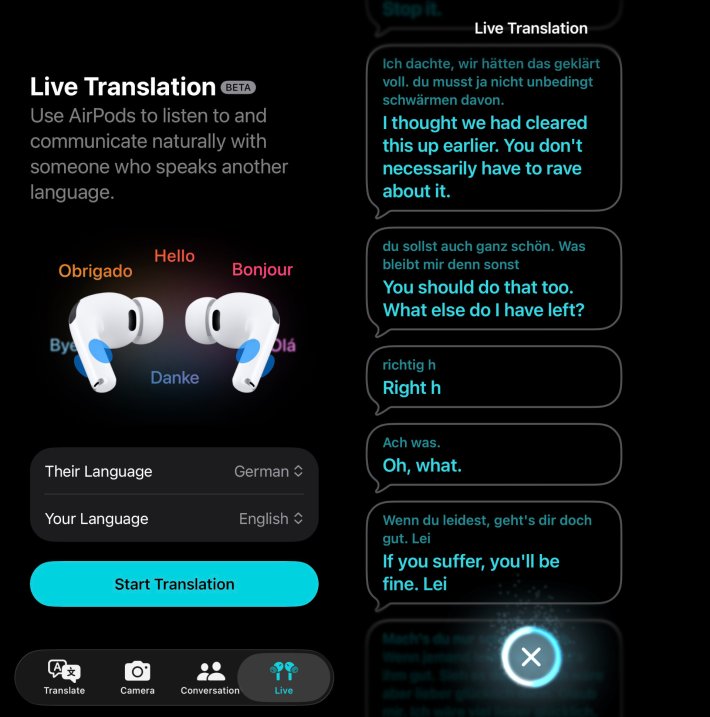
The first thing you will notice if you try to watch a foreign movie with your AirPods Pro 3 is that it’s a terrible idea. It’s not just that there is a 3 second delay to everything, but the translation is contingent upon the speech being accurately picked up to begin with. The AI will often misunderstand what’s being said, causing the translation to shift in and out of coherence. If there is any odd noise, the iPhone gives you a way too wordy warning about reducing ambient noise every single time, interrupting the flow of whatever it was translating. The combination of these factors leads to a surreal experience that feels like you’re having a stroke. I even tried various Spanish children’s TV shows and YouTube channels but it produced nothing approaching legibility. This feature only succeeded intermittently for me with the native speakers in Fassbinder's Ali: Fear Eats the Soul. I even occasionally tried it while listening to adjacent conversations on walks out, and even then it never seemed to fully work. The most plausible use case at this point would be talking to someone who speaks a different language and who is saying simple phrases clearly and loudly at you, but I can’t even begrudgingly say that I care at this point.
Apple can never fail
I’m so conflicted on the AirPods Pro 3. On several basic features (waterproofing, battery, health, noise cancellation, fit) it is a clear, generational improvement. It solved a problem with wearables that I could not solve despite trying everything. For listening to podcasts and taking phone calls it’s fantastic. As a health and lifestyle product, Apple has created a fitness product that others will be tested against for years, a piece of technology that simply works for gym freaks and people in lycra with wraparound sunglasses.
And yet the sound signature of the AirPods Pro 3 is so divisive, weird, chintzy, and distinctly un-Apple. They spent more money than I can conceive of and did obscene amounts of research to make the most advanced earbuds on Earth sound kind of corny. It felt like they went with a sound signature that normal people could tell was different from its predecessor, without interrogating if that was a good idea. And though they could fix these with an update and include at least a fraction of the customizability of every other earbud on the market, I don’t think they will. To do so would be to admit that Apple was wrong about something, and who the fuck are you to tell them that?


